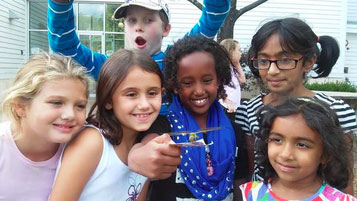 As an elementary teacher of 12 years I often analyzed the traditional classroom setting as something of a puzzle. Aside from learning in the classroom rarely being social (which is how kids learn best) the traditional classroom is set up with kids of the same exact age levels. For what purpose? Most of the kids in any given classroom do not possess the same exact skills set anyway. So teachers end up “differentiating” learning. Sure, I had been part of classrooms where two grade levels had been mixed. This was known as a multi-age classroom setting and though some parents of children in these settings were skittish (is my older child going to be dumbed down? Will my younger child be too challenged?), I always found the notion ideal and realistic to what occurs in the adult world. After all, do adults share office space with people only their own age? Do parents with six children worry that their children are different ages while sharing a home? What does the older employee in the work setting learn from the younger employee? What can the older child give to the younger child? What can the younger child offer to the older child? These questions are easily put to the test in an age-integrated setting. Whereas child care is concerned, this can lead to a healthy mix of children of varying ages working together and learning form one another in many different ways. For the younger child in a child care setting, having someone a few years older to carry you over the finish line on his back during a relay, assist you as you think of ways to solve a problem, help you enhance your dribbling, throwing or catching skills, delegate responsibilities, comfort you when you are sad, or congratulate you when you do something awesome are all amazing advantages that enrich the young child’s life in the child care setting.
On the other end you have an older child of, say, 10-12, who is starting to outgrow some of the little nuances that he so much enjoyed five years earlier. In an integrated setting he now has a new purpose as a role model. All the things he is giving to the younger child become the reward for him as he learns responsibility, leadership, and can see his confidence build as the big man on campus. He has been around for five years and knows the ropes. Now he gets to teach others what he knows and has learned. It continues a journey that has begun when the older child was 5 years old himself. Of course, sometimes parents of children in the child care setting can be concerned about perceived notions of older children as they mix with younger children. For instance, older children curse, infuse early sexual knowledge into the culture of the program, play too hard, can be mean and cruel etc. I am always quick to remind them that such notions are reserved for children of poor character at any age, not necessarily for children who are older. Children who have been raised in a community where the expectations for behavior are high, the rules clear, the consequences for poor choices followed through upon become aware of what their roles are as senior helpers in the integrated setting and act accordingly on this. Integrating children in the child care setting for convenience is one thing. If it is done without thought, without process, without leadership then the consequences can be what every parent of a child in an age-integrated setting may fear. On the other hand, if age-integrating children in the child care setting is purposeful, the activities selected for age-integrated groups thought out, the guidance strong, then operating programs where children of all ages can come together as a community daily can be one of the healthiest environments for any parent’s child. Let’s face it, in the real world we all work together no matter what our ages for the benefit of the larger community. We can all do the same within the microcosm of a child care program. TSL Adventures is a Capital Region based organization that provides before- and after-school child care, vacation programs and summer camps.
0 Comments
The Ideas Written About In This Blog Are Based On The Personal Opinions And Philosophies Of The Contributor Who Has Taught Elementary School For Twelve Years And Has Run A Recreational Childcare Business Since 2009. Leave a Reply. |
|
